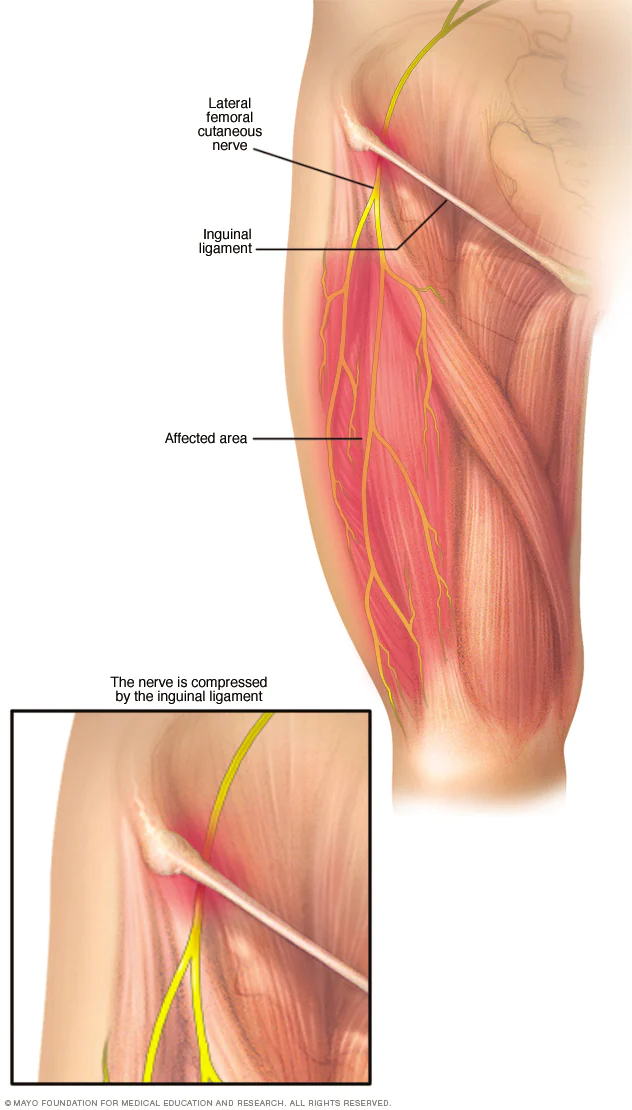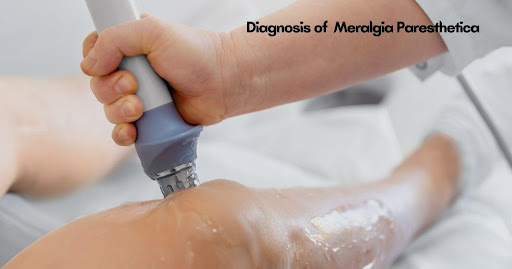Meralgia Paresthetica Causes, Symptoms and Treatment
What is Meralgia Paresthetica

Credits: Mayo Clinic
The compression or firmness of the lateral femoral cutaneous nerve (LFCN), which transmits impulses to the upper thigh, is known as Meralgia Paresthetica or “Bernhardt-Roth syndrome.”
A patient may experience strange buzzing on the thighs due to this illness. It is also associated with numbness (lack of feelings) and discomfort in the upper thighs.
Even though you may not be aware of this disorder, the unpleasant symptoms it generates are practically agonizing and long-lasting.
Causes of Meralgia Paresthetica
When you have Meralgia Paresthetica, your sensory nerves on your outer thigh decrease or get compressed as a result of a sudden impact, trauma, or pressure. This can interfere with the transmission of impulses via the thighs, which is the primary cause of discomfort and stiffness in this sickness.
In other words, any compression of the nerve (which sends impulses) that gives sensation to the skin of your thigh can be the primary cause of this disorder. Including expert physiotherapists, say that it is also caused by tight clothing or stockings or pants that you wear. Obesity or weight increase, and pregnancy can also cause this illness in some cases. Trauma or a diabetic condition can also cause this condition on the thighs.
If you are addicted to alcohol or have hypothyroidism, you are more likely to develop Meralgia Paresthetica. Other causes can include accidents, injuries to hips or knees, agedness, or improper lengths of your legs.
Symptoms
The symptoms are generally only present or detected on one side of your body. Initially, your symptoms may be modest, but as the illness worsens, you may experience stronger or even more intense sensations or agony on the upper thighs. It could disappear and reappear for no apparent cause.
Symptoms of Meralgia Paresthetica can include the following:
- Pain on the outside of the thigh that may extend to the outside of the knee
- Thigh stinging or stabbing pain or numbness of the thighs
- When your thigh is lightly touched, the discomfort began to deteriorate
- Unsettling aching that gets worse after long durations of jogging or standing upright
- Pain in the pelvis that can migrate to the buttocks sometimes
- One of the key causes of Meralgia Paresthetica that should be investigated or considered a symptom is a sudden increase in weight.
Diagnosis and Treatment of Meralgia Paresthetica

For diagnosis at the initial stages, a health specialist may ask you a range of questions. This will help the doctors to find the root causes of Meralgia Paresthetica. Thyroid hormone levels, B vitamin levels, lead levels, and symptoms of conditions like anemia and diabetes may all be checked with blood tests if asked by your doctor. Other ways to diagnose this issue are as follows:
- Imaging tests are performed mainly for the diagnosis of Meralgia Paresthetica. In order for analysis, specialists may conduct Imaging tests to see the images of the interior of your hip and pelvic area to figure out any issues for Meralgia Paresthetica. For this purpose, X-rays, a CT scan, or an MRI may be scheduled by the diagnosis specialist.
- Electromyography is a method of assessing and documenting the electrical impulses of skeletal muscles. This sickness on the thighs is diagnosed using an electromyograph, which creates a record called an electromyogram. The findings of Electromyography will be normal even if you are suffering from Meralgia Paresthetica; however, it may indicate other sources of the illness.
It has been observed that the symptoms of Meralgia Paresthetica usually go away within a few months. In the case of an acute condition, however, the treatment relies primarily on reducing nerve compression on the outer skin of the thighs. As per experts, Physiotherapy can certainly treat this disorder.
How does Physiotherapy help in Meralgia Paresthetica?
A physiotherapist can create a treatment plan to help you manage the discomfort and pain associated with Meralgia Paresthetica, no matter what the cause is. The Physiotherapist will help to treat the hip or pelvis if the condition is caused by a problem there. Their purpose is to decrease or remove the nerve compression happening during the illness. Additionally, Physiotherapy can help with the following things.
- Physical therapists can help with a variety of pain-relieving techniques.
- Self-stretching techniques (to restore normal motion in the back, hip, and leg by reducing muscle tension) may be offered to you by the therapists.
- Based on your age, symptom level, and body condition, a Physiotherapist will determine which exercises are appropriate for you.











